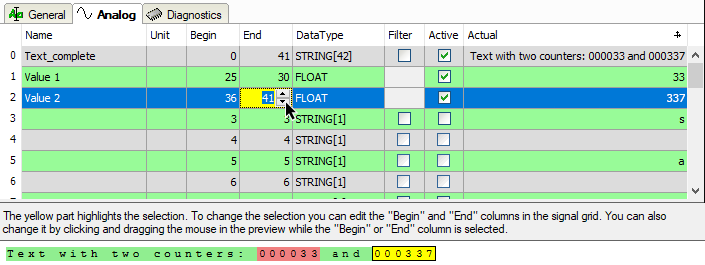The Fixed width mode is best selected when the input text always has the same length and all information within the text is always at the same place, and therefore always has the same number of characters.
In this mode, you must set a start and stop index for the first and last character for each (text) signal that you want to derive from the input text. You can set this in the Analog or Digital tab of the module.

If a text has already been received, then it is shown in the preview area under the signal table.
To determine the character area, you can manually enter the start and stop values in the Start or Stop columns or set them with the spinner buttons. The index for the first character in the text is zero (0). You can also apply this method if no text has been received yet, but you already know the structure.
If an input text is already visible, then you can alternatively use the mouse: Click in the line of the desired signal with the mouse in the column Start or Stop. Then click in the preview area on the first character in the text for the desired signal, keep the mouse button depressed and drag the mouse to the last character. The selected area will be highlighted in yellow and the indexes will automatically be updated in the Start and Stop columns.
Then set the desired signal data type. This can either be a text (STRING[x] type) or a numerical data type. In the latter case, the text is parsed in order to generate a numerical value. If a decimal mark is used within the numbers in the text, ensure that the decimal mark (period or comma) is correctly set in the General tab.
The different colors refer to the following states in the preview area:
|
Color |
Description |
|---|---|
|
Green (1) |
All characters of the text associated with a text signal are highlighted in green. |
|
Red (2) |
The red color indicates characters in the text which are assigned to multiple text signals. |
|
Yellow (3) |
The characters of a text signal selected in the table are highlighted in yellow. |
(1) = least dominant, (3)= most dominant color